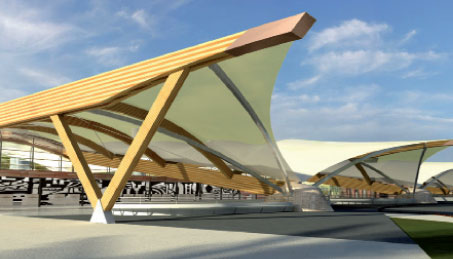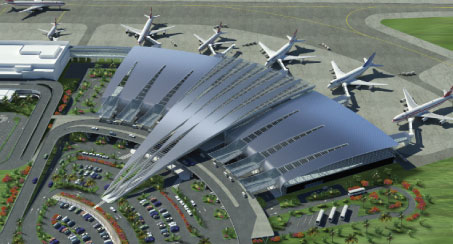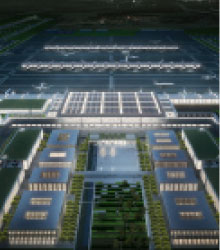
Rouverand: “Airport design is at the heart of our work, which is what enables us to provide airports with the best possible advice and assistance.”
Faced with increasing energy costs, pressure from local residents, global warming and substantial incentives from local authorities, airports and airlines alike have a leading role to play in bringing about changes to working practices and mentalities.
“The majority of airports have plenty of room for improvement when it comes to saving energy or implementing renewable energy projects,” said Etienne Rouverand, head of sustainable design, ADPI.
ACI EUROPE’s Airport Carbon Accreditation has been developed as the carbon standard for airports; its purpose is to assess and recognise the efforts of airports to manage and reduce their carbon emissions with four levels of award: Mapping, Reduction, Optimisation and Neutrality.
“Doing this is, therefore, clearly a self-evident condition for their necessary development. It allows them to embark on a virtuous course of growth, based on a controlled energy policy.”
In order to help airports achieve their carbon reduction targets, ADPI offers a specific partnership deal. “Airport design is at the heart of our work, which is what enables us to provide airports with the best possible advice and assistance,” Rouverand said. “The carbon footprint that we leave in the first place provides us with a diagnosis of energy consumption. The emissions management plan enables emissions quantities to be reduced depending on their source. We also assist airports in all their external audit procedures.”

Mauritius Airport, designed by ADPI. Photovoltaic panels have been integrated into the entrance canopies.
Methodical approach
In Europe, as part of its promotion for sustainable development, ADPI supports the Airport Carbon Accreditation approach. Rouverand continued: “This policy requires a methodical and comprehensive approach, combined with genuine knowledge with respect to airport design, and a thorough understanding of the regulations governing greenhouse gas emissions.” Once this approach has been embraced by the airport, it can then encourage all of the economic stakeholders to contribute to the same aims, he explained.
Widespread research and specific studies are also central to ADPI’s approach to helping airports develop sustainably. Naturally, the duration and scope of the studies varies depending on the size of the airport in question, but each of them take into account all the activities of the airport in order to calculate the CO2 emissions.
Talel Jaouad, ADPI’s carbon strategy manager, explained: “We apply internationally recognised standards. Beyond the carbon footprint, our expertise allows us to detect all excess consumption of energy so that we can suggest action plans aimed at reducing emissions. We repeat the carbon footprint in the following year and we provide assistance to the airport at each stage of the accreditation, up to carbon neutrality.”
Building new solutions
Lindner undertakes major worldwide projects in all areas of interior finishes, insulation technology, industrial services and building facades. From pre-planning through to project completion Lindner is your partner of choice. The company’s extensive manufacturing capability enables quality to be strictly maintained whilst allowing maximum flexibility to meet individual project requirements. Environmental considerations are fundamental to all Lindner’s business principles.
With long-term expertise in the airports and airlines business Lindner focuses mainly in the interior fit-out of comfortable passenger terminals, exclusive lounges and fashionable shop areas.
Several demanding projects have been successfully carried out and are among numerous references worldwide. The company’s key-account team for the airports and airlines sector takes account of all specific requirements and has vast experience to handle demanding site conditions. The new head of the department, Martin Schmidhuber, and his team offer all necessary and individual services for a smooth running project with Lindner’s sustainable and environmentally friendly products.
GMP’S ARCHITECTURAL INNOVATION

gmp Architekten has played an integral role in the design of Berlin Brandenburg International Airport, which boasts a number of innovative and environmentally efficient design features.
German company gmp Architekten provides an example of a company dedicated to ensuring that airports are developed in an environmentally sustainable manner. The company has played a major role in a number of significant airport developments, including recent developments at Frankfurt, Hamburg and Stuttgart, while it has also played a major role in the design of Berlin Brandenburg International (BBI) Airport.
Referring to the role that environmental sustainability has played in the design process, Hajo Paap, partner at gmp Architekten, explained: “The holistic view of the configuration of the building in interaction with the run-up layout and the location of the runway system guarantees optimal path lengths for the passengers and taxiways for the aircraft. Optimised transport processes are the basic requirement for minimum emissions, as well as land use.”
He continued: “The one-roof concept – the clearly structured building arrangement in connection with the storey organisation – is available at the airport for the shortest paths and a definite orientation. This is in view of the interventions in the landscape and the groundwater equally, as well as in the construction of the buildings and roads. Short paths lead to improved surfaces, thus minimising energy consumption.”
Throughout the BBI project, examples of innovative environmental efficiency are evident. For instance, gas turbine cogeneration will be the primary energy source, while rainwater will be collected in cisterns and used for adiabatic cooling and greywater use. The ventilation and air-conditioning is based on the principle of a free-flow micro-climate, and the air is conditioned only in the places, and to the extent, that it is needed.







